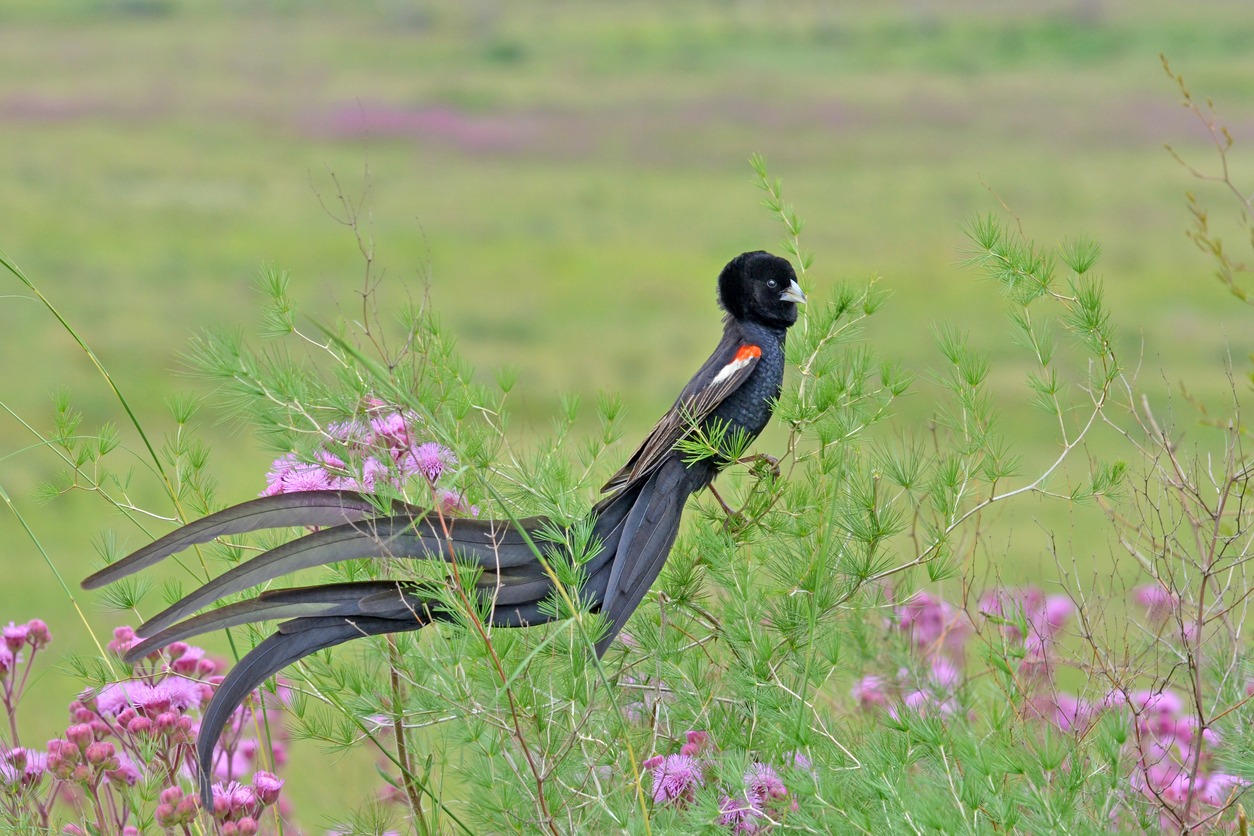It is a large darkish widowbird, whose males are conspicuous in their breeding plumage due to their massive tail, and red and white streaks on their broad dark wings. Females sport a brown and streaky plumage throughout the year. Prefers moist grasslands, open habitats, and cultivated areas, occurring in flocks, especially outside the breeding period. Song is characterized by a warbling sound.
Read further to know more about the Long-tailed Widowbird.
What is a Long-tailed Widowbird?
Long-tailed Widowbird (Euplectes progne) is a bird species belonging to the Ploceidae family. Also known as “Sakabula,” this fairish-sized passerine is a common bird on its range, and its males are easily distinguishable through their extremely long tail, which they use for their courtship and flight displays.
Its seven levels of classification are as follows:
Kingdom: Animalia
Phylum: Chordata
Class: Aves
Order: Passeriformes
Family: Ploceidae
Genus: Euplectes
Species: E. progne
Long-tailed Widowbird Physical Description
Long-tailed widowbirds display a unique sexual dimorphism, with both sexes exhibiting differences in their morphological and behavioral characteristics. Males are entirely black, with orange and red shoulders, white wing tetrices, and dark underwing coverts. Meanwhile, the bill has a bluish-white tone. Males are renowned for their incredibly long tails that consist of 12 tail feathers, six to eight of these grow approximately 20 inches long.
Females have a paler plumage. The upperpart is speckled with tawny or buff and black. Their breasts, chest, flanks are even duller than the upperparts. Parts under the wing tetrices are blacks, while tail feathers are thinner and pointed. The bill is light-brownish.
During the non-breeding period, both sexes look the same, with the males sporting the same color as the females’. An exception is that males are more speckled above and the tail is shorter, but retaining the breeding characteristics of their wings and wing shoulders. Immature birds or juveniles display the female plumage. Males are relatively larger than the females.
Where can they be spotted?
Long-tailed Widowbirds thrive in swampy or open grasslands, marshy areas, tall grasses, cultivated areas, and other open habitats. It has three isolated populations, one extended from Angola to Zambia, another from southern DRC to southern Africa, while the last occurs in Kenya. These birds are locally common in Lesotho, eastern South Africa, and stretching to Botswana’s southeastern part.
Interesting Facts You Should Know About the Long-tailed Widowbird
Long-tailed Widowbirds are omnivorous, feeding primarily on seeds and occasionally on arthropods. They forage mainly on the ground but can be observed hawking their prey on the wings. The food items it consumes includes seeds of the common paspalum, couch paspalum, whet, rooigras, twisted-leaf bristle grass, groundsel, and Kikuyu grass, and insects, such as beetles, aphids, cicadas, and even spiders.
These birds are polygynous, which means that breeding males may have more than one to five breeding females in the territory at a given breeding period. The male is territorial and will mightily defend his territory from the other males.
Whenever a female enters his range, the male long-tailed widowbird will perform flying displays to attract the female. He flies with hefty and slow wingbeats while flashing his long tail. Females often visit various territories before mate selection.
The egg-laying season occurs from October to June, peaking from November to February. The female long-tailed widowbird weaves a dome-like nest, using seed heads and long grass. She will lay 2 to 3 eggs, which she will solely incubate for about 12-14 days. Chicks will singly be fed by the female and will soon fledge 17 days after hatching. However, broods will stay dependent on the mother for about two weeks more.
Long-tailed Widowbirds’ populations are not threatened. While they face threats due to frequent fires, human settlement, overgrazing, and commercial afforestation, their number is currently stable. They are classified as Least Concern (LC) under the IUCN Red List of Threatened Species.
WILDLIFE PARKS AND RESERVES WHERE THIS SPECIES IS FOUND:
SOUTH AFRICA
BOTSWANA BIRDS | SOUTH AFRICA BIRDS
NAMIBIA BIRDS | ZAMBIA BIRDS | ZIMBABWE BIRDS

